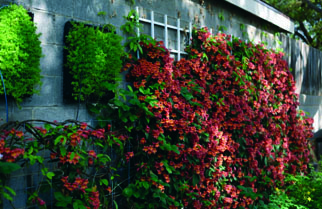By Debbie Roland and
Emmy Ulmschneider
Master Gardeners
Next time you are looking for a plant to dress up a fence, building or just want to add a trellis with color, consider Crossvine (Bignonia capreolata). It is easy to grow and clings to most surfaces with its tendrils, making it a great plant for adding a privacy area to your yard. Crossvine can climb nearly anything because it has holdfasts: adhesive discs on the end of each tendril.
The foliage is gold/chartreuse sporting showy red or orange flowers. Crossvine grows up to 20’ high and 6’ to 9’ wide in sun or part sun. If you choose part sun, don’t expect as many flowers as you will get with full sun. In full sun it is a heavy bloomer almost covering the vine itself. It smells wonderful (to us and to pollinators) and is low maintenance.
Plant in well-drained soil and water during the first growing season to establish strong roots. Once established, you can water less. During winter when there are no more blooms, cut the vine back by half, or more if needed to keep it where you want it grow next year. It blooms on new growth so do not be afraid to trim it back! When you do, look at one of the large woody stems and you will see the cross-like markings that give this plant is common name, Crossvine.
If you pair this plant with other pollinators, like coneflower, Joe Pye weed and bee balm, it provides a virtual buffet for hummingbirds and other pollinators.
Crossvine is a wonderful alternative to the many non-native, often invasive vines, we choose for our landscape. Consider replacing your English ivy, coral vine or wisteria with a native. And if you grow it, you get hummingbirds that pollinate the tubular flowers.
In our area this plant is semi-evergreen and has color and interest all year round. The bright green leaves turn a reddish-purple in winter and the flowers give way to greenish pod-like capsules that stay on the plant.
Don’t confuse this plant with Trumpet Creeper, an invasive native vine you see in alleyways, climbing telephone poles and covering arbors and fences. Crossvine looks like its wild child close cousin but is manageable, better mannered with beautiful blooms.
This plant is not deer tolerant.
For more information, call the AgriLife office at 498-4071 in Odessa or at 686-4700 in Midland or visit aggie-horticulture.tamu.edu or westtexasgardening.org.




